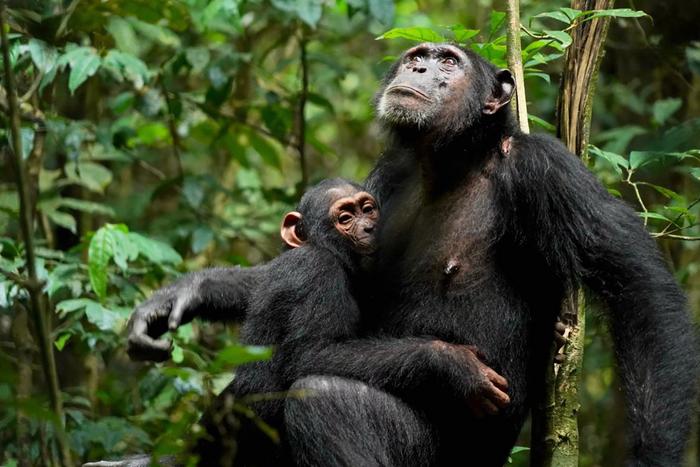In a groundbreaking study published in Nature Human Behaviour, researchers have revealed striking insights into the nature of mother-offspring attachment patterns among wild Western chimpanzees (Pan troglodytes verus). The findings illuminate the evolutionary roots of social and emotional development, challenging previously held assumptions derived mainly from human and captive primate studies. Over a meticulous four-year observational period in Taï National Park, Côte d’Ivoire, scientists documented that wild chimpanzee infants exhibit clear distinctions between secure and insecure-avoidant attachment types, but critically, show no evidence of disorganized attachment—a category often linked to maltreatment and psychological dysfunction in humans and captive animals.
Attachment theory, a cornerstone of developmental psychology, posits that early relationships between infants and their primary caregivers profoundly influence emotional regulation, social competence, and cognitive development. Secure attachment, characterized by an infant’s confidence in their caregiver’s availability and support during distress, facilitates exploration and resilience. Conversely, insecure-avoidant attachment describes an adaptive distancing strategy where infants minimize proximity-seeking behavior, presumably to cope with less responsive caregiving. The identification of these patterns in wild chimpanzees suggests that attachment behaviors might not only be uniquely human but are deeply embedded within evolutionary biology.
One of the study’s most salient revelations is the complete absence of disorganized attachment behaviors among the observed wild chimpanzees. In human infants, disorganized attachment often arises from experiences of fear or trauma linked to caregivers, manifesting as contradictory or confused behaviors that undermine effective emotional regulation. Such patterns are correlated with heightened risks for long-term mental health issues, including anxiety and difficulties in forming stable relationships. Intriguingly, while captive chimpanzees—especially orphans raised in human care—frequently display signs of these disorganized attachments, wild chimpanzees appear to circumvent this maladaptive strategy entirely. This divergence emphasizes the potent role of naturalistic, stable social environments in fostering healthy attachment development.
The researchers hypothesize that disorganized attachment may be evolutionarily disadvantageous in the wild, where survival depends on reliable social bonds and predictable caregiver responsiveness. Unlike captive settings where orphaned chimps endure inconsistent care, wild chimpanzees grow up within cohesive family groups that provide continuous maternal presence, social stability, and environmental feedback crucial for normative attachment formation. The severe survival pressures, including predation risk and resource competition, likely act as selective forces that eliminate individuals unable to form organized attachments necessary for effective social integration and coping.
Methodologically, the research team employed rigorous behavioral coding of mother-infant interactions, leveraging ethological frameworks adapted from human attachment assessments such as the Strange Situation Procedure. Chronicling nuanced responses to separations, reunions, and environmental challenges allowed for precise classification of attachment types. This approach bridged psychology with primatology and anthropology, offering a rare empirical intersection that enhances our comprehension of attachment as an evolved trait extending beyond Homo sapiens.
The implications for human parenting and caregiving practices are profound. The striking similarity between chimpanzee and human secure and insecure attachment categories, coupled with the contrasting prevalence of disorganized attachment in modern human societies, prompts critical questions about the impact of contemporary caregiving environments. Increasingly, artificial institutions such as daycare centers, foster care systems, and other non-familial caregiving arrangements may inadvertently potentiate attachment disruptions. This study encourages a reevaluation of such practices through an evolutionary lens, emphasizing the importance of consistent, responsive, and stable caregiving to nurture optimal social and emotional development.
Furthermore, this research underscores the plasticity and adaptability of attachment systems in response to environmental pressures. For wild chimpanzees, stable maternal bonds are integral to the development of social confidence and resilience, traits necessary for navigating complex social hierarchies and ecological challenges. For humans, understanding these ancestral attachment mechanisms may inform interventions aiming to mitigate the adverse effects of early adversity, reinforcing the therapeutic potential of fostering secure attachments during critical developmental windows.
From an evolutionary perspective, the absence of disorganized attachment in wild chimpanzees suggests that this attachment form, although prevalent in humans and captive animals, may represent a comparative anomaly resulting from environmental disruptions rather than an inherent species-wide strategy. The findings align with the theory that shared attachment mechanisms among primates reflect a common evolutionary heritage, where attachment security confers adaptive benefits critical to survival and reproductive success.
This study also invites interdisciplinary discourse by linking behavioral ecology with mental health research. Understanding how early life social experiences translate into complex emotional regulation across species advances not only anthropological knowledge but also informs psychological practice by unveiling deep-rooted biological substrates of attachment. The data encourage cross-species comparisons that may reveal conserved neural and hormonal pathways implicated in attachment behaviors.
Ultimately, these insights challenge us to reflect on current human social systems and caregiving institutions. The divergence between natural attachment patterns in wild chimpanzees and those observed in human children and captive chimpanzees signals that societal changes may not always align with evolutionary optimality. Modern life’s complexities, including parental stress, institutional care, and social fragmentation, might partly explain the heightened incidence of disorganized attachment in human populations. Future research is poised to explore how contemporary environmental factors reshape innate attachment tendencies and what strategies could promote healthier developmental trajectories.
The rich, uninterrupted mother-offspring bonds observed in Taï National Park not only deepen scientific understanding of attachment’s biological roots but also beckon society to cherish and prioritize stable, nurturing relationships during infancy. This foundational research marks a milestone in primate behavioral science and psychology, offering a viral-worthy narrative that connects the intimate worlds of chimpanzees and humans through the shared language of attachment.
Subject of Research: Mother-offspring attachment patterns in wild Western chimpanzees (Pan troglodytes verus).
Article Title: Evidence of organized but not disorganized attachment in wild Western chimpanzee offspring (Pan troglodytes verus).
News Publication Date: 12-May-2025.
Web References: 10.1038/s41562-025-02176-8
Image Credits: © Liran Samuni, Taï Chimpanzee Project.
Keywords: attachment theory, chimpanzee behavior, secure attachment, insecure-avoidant attachment, disorganized attachment, primate social development, evolutionary psychology, maternal bonding, wild primates, developmental ethology.




